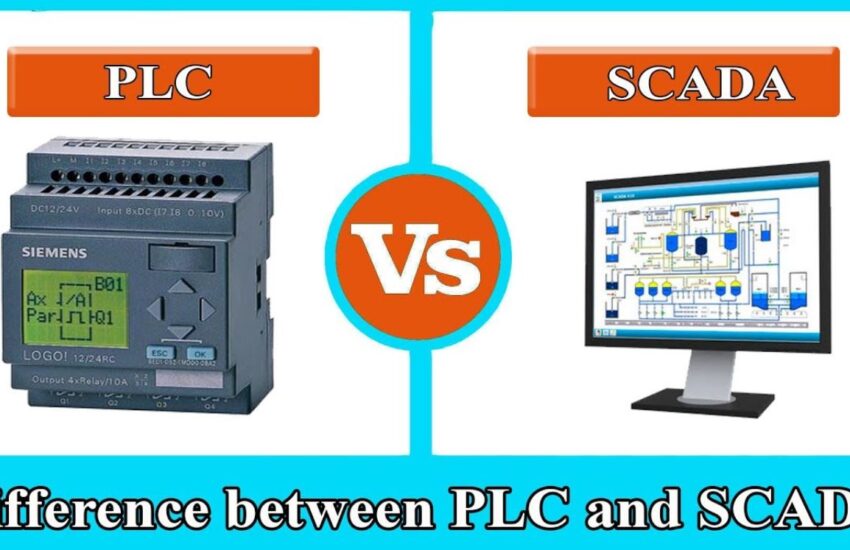PLCs (Programmable Logic Controllers) and SCADA (Supervisory Control and Data Acquisition) systems typically work together in industrial automation and control applications. They perform a variety of linked but different duties inside a control system. Following is a summary of the relationship between PLCs and SCADA:
1.PLCs as Local Control Units:
Allen Bradley MicroLogix 1400 PLCs handle local control and automation at the machine or process level. They receive signals from sensors, switches, and other field devices, process the logic of the control system in accordance with preprogrammed instructions, and then output signals are sent to control actuators and other devices. PLCs oversee tasks like real-time control operations, control algorithm execution, and process variable monitoring.
- Input / Output Handling: PLCs interface to a range of field devices, such as sensors, switches, actuators, motors, and valves, in order to collect input signals and generate output signals. They receive input signals from sensors, which may include data on temperature, pressure, flow rate, level, and other process variables. These inputs are processed by the PLC to decide how to control things.
- Control Logic Execution: The control logic or software that specify how the controlled system should act and operate are carried out by PLCs. The control logic is typically created using programming languages designed specifically for PLCs, such as ladder logic or function block diagram (FBD). The logic makes use of conditional statements, clocks, counters, mathematical operations, and other instructions to control the sequence of events and responses to input conditions.
2. SCADA as a Centralized Monitoring and Control System:
SCADA systems, on the other hand, provide a centralised platform for the monitoring, data collection, and management of several PLCs and other devices throughout an entire industrial process or facility. They collect data from PLCs and other field devices, display real-time data through graphical user interfaces, provide tools for handling alarms, trend analysis, and reporting, and enable remote operator interaction with the system.
- Data Acquisition: SCADA systems use a variety of devices to collect real-time data, including PLCs (Programmable Logic Controllers), RTUs (Remote Terminal Units), sensors, metre, and other field devices. They collect data on process variables, the state of the apparatus, warnings, events, and other relevant specifics. The data acquisition is done via communication protocols like Modbus, DNP3, or OPC, which allow for easy data exchange with connected devices.
3.Communication and Data Exchange:
Communication protocols are necessary for PLCs and SCADA systems to exchange data. For real-time process data, status updates, and alarm notifications, PLCs communicate with SCADA systems. For remote control and parameter changing, PLCs receive control instructions and setpoints from SCADA systems. Communication technologies including Ethernet/IP, Profibus, and Modbus are frequently used for this purpose.
- Communication Protocols: Communication protocols set the rules and benchmarks for information transfer between devices. Industrial automation uses a variety of protocols, including Modbus, Profibus, Profinet, Ethernet/IP, DNP3, OPC (OLE for Process Control), MQTT (Message Queuing Telemetry Transport), and many more. These protocols permit error-free communication between devices created by different firms by defining the structure, format, and encoding of data packets.
- Wired and Wireless Communication: Networks can be wired or wireless, and both can be used for communication. Fast and dependable data transfer is possible via wired connections like Ethernet, RS-485, RS-232, and Fieldbus. Wireless technologies like Wi-Fi, Bluetooth, Zigbee, or cellular networks provide flexibility and mobility for devices that require remote communication or mobility.
- Data Acquisition: Equipment like PLCs, RTUs, and sensors collect data from field devices and sensors. This data consists of process variables, equipment status, alarms, events, and other relevant information. It may be necessary to scale, filter, or transform the acquired data before transmission because it is often in analogue or digital form.
4.Integration:
To work together, PLCs and SCADA systems are widely used. SCADA systems can access data from several PLCs, which they then combine into a single view for operators. They display historical trends, current data, and alerts from several PLCs in a single interface. PLCs then take advantage of the extensive visualisation, data analysis, and reporting capabilities provided by the SCADA system.
- Device Integration: Linking and coordinating various system components is required for integration. In addition to PLCs (Programmable Logic Controllers), DCS (Distributed Control Systems), SCADA (Supervisory Control and Data Acquisition) systems, and HMIs (Human-Machine Interfaces), this includes sensors, actuators, motors, drives, and other field devices. Integration enables data exchange, control commands, and operational synchronisation between diverse devices.
- Communication Protocols and Standards: Integration requires the use of compatible communication standards and protocols. Devices and systems should be able to support Modbus, Profibus, Profinet, OPC (OLE for Process Control), Ethernet/IP, MQTT (Message Queuing Telemetry Transport), and other industry-specific protocols. Standard protocols ensure smooth communication and interoperability between devices from different manufacturers.
5. Hierarchy and Functionality:
PLCs and SCADA systems operate at several levels of the control hierarchy. PLCs handle real-time control duties at the machine or process level, whereas SCADA systems provide supervisory control and data collection capabilities. PLCs are more focused on data visualisation, analysis, and higher-level control than SCADA systems are.
- Control Level: Automation and local control are handled by devices at the control level. PLCs (programmable logic controllers) or remote terminal units (RTUs) are typically found on this level. PLCs and RTUs gather information from field devices, execute control algorithms, and provide output signals that actuators and other devices in a machine or process can react to.
PLCs and SCADA systems collaborate and cooperate across the board. PLCs are responsible for local control and automation while SCADA systems provide a centralised platform for monitoring, data collection, visualisation, and remote control over a number of PLCs and devices. This integration makes it possible to manage industrial operations thoroughly and effectively, ensuring maximum production, security, and efficiency.
